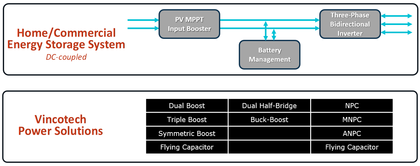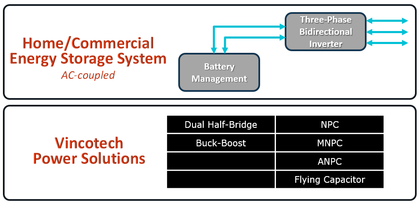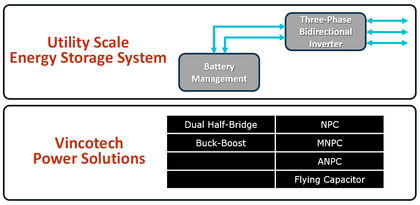Energy Storage Systems
Energy Storage Systems (ESS) can be deployed at either the
- Home/commercial level to create utility independent renewable (solar, wind etc.) energy sources - so called “behind the meter” or at the
- Utility scale level to help minimize grid fluctuations during peak-demand periods – so called “before the meter”.
Both scenarios require the use of
- storage sub-system, commonly batteries, to store the energy,
- bidirectional converters for charging and discharging the storage sub-system, and
- a management system to manage the charging, discharging and safety of the storage sub-system
Home/commercial systems

Home/commercial systems can be either
- DC-coupled, where the DC output of the solar multi power point tracker (MPPT) is combined with the DC output of the energy storage sub-system on a common DC-Bus and fed to the output inverter – typically single phase in a home application and three-phase in a commercial system, or

- AC-coupled, where the bidirectional AC output of the standalone ESS system is combined with the AC output of the existing solar inverter at the grid connection point. This system provides an easy route to upgrade an existing solar installation.
Utility Scale systems

Utility Scale systems are similar to the home/commercial AC-coupled architecture, where the ESS is connected to, and charged from, the grid. However, typically the energy storage sub-system has
- Greater storage capacity and uses either a fixed or modular battery architecture, and
- Higher output voltage (>700V) which can simplify the DC-bus architecture.
Due to the higher DC-bus voltage and higher output power, various three-level bidirectional inverter topologies are used, depending on system design requirements and complexity.
Three-level bidirectional inverter topologies
Three-level topologies have become popular in the inverter due to their key advantages:
- increased efficiency, leading to smaller and lighter heat sinks,
- lower harmonic content, requiring less filtering, and
- lower EMI.
Vincotech offers a range of different bidirectional inverter topologies for ESS.
- NPC, and the recently enhanced version, the ANPC, allow use of cost effective 650V components and offer superior efficiency at >8kHz.
- MNPC offers the key advantages of inherently safe operation in fault conditions and higher efficiency at operating frequencies <8kHz.
- Flying capacitor inverters have similar efficiency as NPC/ANPC topologies, but the added feature that the inductors operate at 2x the frequency of the inverter switches, which can lead to smaller and lighter inductors.
Downloads
- Vincotech_FLYER_Energy-Storage-Solutions.pdf – PDF, 7 MB

